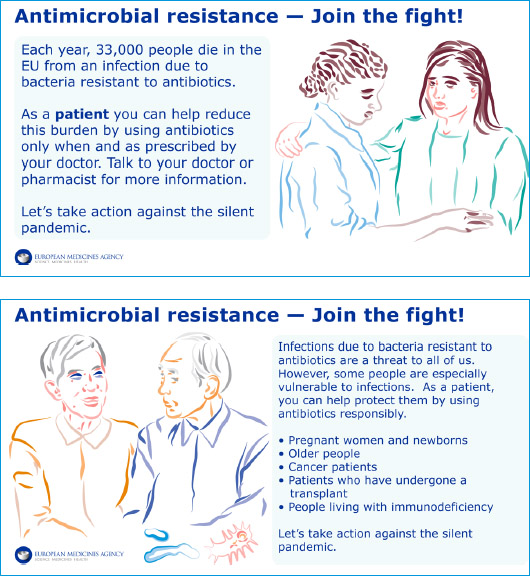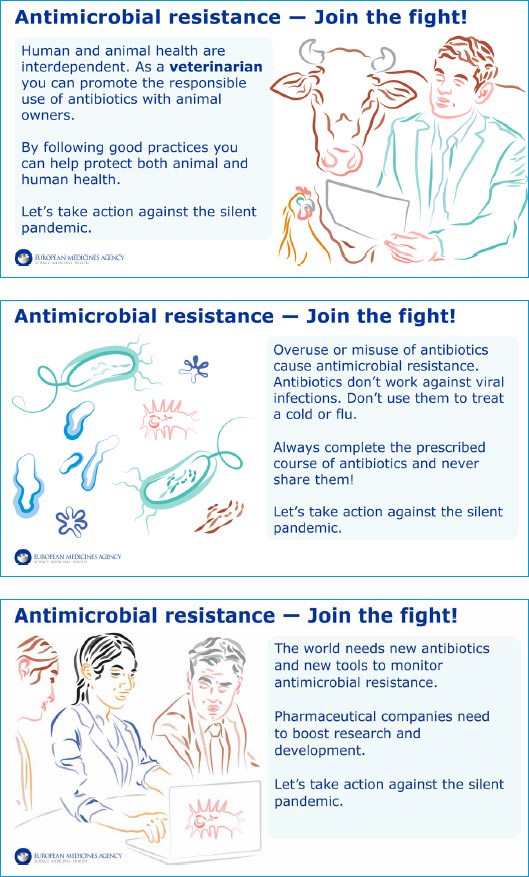
Fighting antimicrobial resistance
AMR is a global threat to animal and human health that requires coordinated action across all government sectors and society. It threatens the effective treatment of infections caused by an ever-increasing range of bacteria and other microorganisms that have become resistant to available treatments. Tackling AMR continued to be a high priority for EMA and the European medicines regulatory network in 2021.
EMA supports a 'One Health' approach, promoting close and integrated cooperation between the human and veterinary fields.
Antimicrobial resistance is a silent pandemic that could have disastrous consequences for modern medicine. We need to act now to preserve antibiotics. At EMA, our experts are working relentlessly to ensure that effective antibiotics against infectious diseases in people and animals remain available to everyone in the EU.
Responsible use of antimicrobials in animals
In January 2021, EMA’s committee for veterinary medicines (CVMP) adopted a strategy on antimicrobials for 2021-2025. The strategy aims to secure the availability of effective antimicrobial medicines for the treatment of serious infectious diseases in animals, while minimising the risks to animals or people emerging from their use. It provides a status report on ongoing activities on antimicrobials and sets out proposed actions for the CVMP during the next 5 years.
The CVMP strategy on antimicrobials will deliver provisions in the Veterinary Medicines Regulation (Regulation (EU) 2019/6) that derive from the European ‘One Health’ action plan against antimicrobial resistance. The new Veterinary Medicines Regulation aims to increase the availability and safety of veterinary medicines, promotes responsible use of antimicrobials in animals and enhances EU action against antimicrobial resistance.
Decrease in sales of veterinary antimicrobials
European countries have substantially reduced the use of antimicrobials in animals according to the annual ESVAC report, published by EMA in November 2021 and reporting data for 30 countries from the EEA and Switzerland. Data from the 25 countries that provided input for the full 2011-2020 period showed overall sales of veterinary antimicrobials in European countries were 43% lower in 2020 than in 2011. While an increase of 6% in overall sales for the 25 countries in 2020 compared to 2019 was registered, data for the next years are necessary to better understand this observation.
The decrease in sales of antimicrobials for use in animals over ten years shows that EU policy initiatives combined with guidance and national campaigns promoting prudent use of antimicrobials in animals are having a positive effect.
Sales of those antimicrobials that are considered critically important for use in humans noticeably decreased between 2011 and 2020 and accounted for only 6% of total sales in 2020.
Scientists, veterinarians and other animal healthcare professionals, risk assessors and policy makers in Member States use the results of the annual ESVAC report as a reference for antimicrobial policies and for guidance on the responsible use of antimicrobials. Under the new Veterinary Medicines Regulation, reporting data on sales and use of antimicrobials in animals will become a legal obligation for EU Member States and the Agency from 2023.
Joint inter-agency antimicrobial consumption and resistance analysis (JIACRA) report
In June 2021, EMA, the European Food Safety Authority (EFSA) and ECDC published the third JIACRA report, which presented data on antibiotic consumption and development of AMR in Europe for 2016-2018. The report highlighted that the use of antibiotics has decreased and is now lower in food-producing animals than in humans.
The significant fall in antibiotic use in food-producing animals suggested that the measures taken at country level to reduce use are proving to be effective. However, the report also showed that the picture in the EU is diverse as the situation varied significantly by country and by antibiotic class.
Supporting the international fight against AMR
EMA continued to work with its EU and international partners on a number of initiatives aiming to address the global public health problem of AMR. In 2021, these included contributing to the ICMRA campaign during World Antimicrobial Awareness Week in November and other global initiatives to combat antibiotic resistance, such as the Transatlantic Taskforce on Antimicrobial Resistance (TATFAR).
The progress of TATFAR and its achievements in tackling AMR were reviewed at a conference held on 14-15 September and are summarised in a 2016-2020 progress report. The report outlines the actions to fight AMR in three key areas: appropriate therapeutic use of antimicrobials in human and veterinary medicine; prevention of drug-resistant infections; and strategies for improving the pipeline of new antimicrobial medicines. As member of the taskforce, EMA has contributed to the implementation of strategies to encourage responsible use of antimicrobials in veterinary medicines and to foster research and development of new safe and effective human antibiotics.
Fighting the silent pandemic
To mark European Antibiotic Awareness Day in 2021, EMA launched a social media campaign to highlight the importance of using antibiotics prudently. A collection of info-cards focused on what patients, healthcare professionals, veterinarians, public health leaders and the pharmaceutical industry in their respective roles can do to make sure that these important medicines remain available as effective treatments for EU patients.


Watch the EAAD 2021 message by EMA’s Executive Director Emer Cooke
This content is hosted by a third party. By viewing this external content, you accept the terms and conditions of youtube.com
In support of the World Antimicrobial Awareness Week 2021, EMA joined an ICMRA campaign aiming to raise awareness of the growing public health problem of AMR and the need to address it. The Agency disseminated a set of info-cards to call on global health leaders, healthcare professionals and patients to take action.